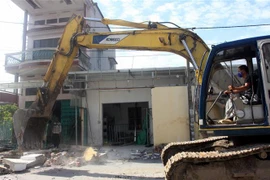Lastyear, despite many difficulties from the COVID-19 pandemic, Thai Binh still enjoyedgross regional domestic product (GRDP) growth of 3.23 percent, a relativelygood level compared to the country’s average.
Theper capita income of Thai Binh reached about 2,100 USD per year in 2020.
ThaiBinh also completed its targets in new-style rural area building three yearsprior to its plan, while 100 percent of its rural residents got access to cleanwater. Meanwhile, administrative reform in the province continues to bestrengthened.
Inthe 2011-2020 period, garment and textile were among industries playingthe core role in export activities of the province, creating many jobs andhelping increase income for labourers, thus affirming its key position in theprovince’s socio-economic development strategy.
Businessesengaging in supporting industry for garment and textile and leather are mostlyproviding dyeing and fabric materials. Currently, Thai Binh has 41 firms oeparating in the supportingindustry, 23 of which in textile dyeing and 18 others in fiber andyarns production. Major markets for textile and yarn products of local enterprisesare European countries, Japan, the US, Taiwan (China) and China as well as thedomestic market. This is one of the great advantages of the province in developingthe supporting industry for textile and garment.
ThePeople’s Committee affirmed that along with garment and textile, mechanicalmanufacturing and pottery are also important industries of Thai Binh. Therefore,in its overall development strategy, the province will focus on boosting thegrowth of supporting industries for garment and textile, electronics, mechanicalmanufacturing and pottery ,considering them as breakthrough sectors for the province’s industrialdevelopment in the next period.
Inorder to attract more investment to these industries, Thai Binh has designed anumber of plans and solutions, concentrating on breakthrough measures such as promotingadministrative reform to create a favourable environment for investment, developinghuman resources for supporting industries by expanding training activities tosuit the labour demands of businesses, strengthening the use of information technology intraining activities, and prioritizing traning programmes based on the needs of enterprises.
Aspart of efforts to create motivation for the overall growth of the industrialsector and supporting industries in particular, the province will continue towork to remove obstacles facing local firms in the process of attractinginvestment and expanding export markets.
ThaiBinh will also assist a number of sectors such as garment and textile,electronics and mechanics to engage in the global supply chains. At the sametime, the locality will also encourage technology modernisation to enhance thecapacity of local firms in designing and promoting their trademarks.
Inthe first six months of this year, the industrial sector still enjoyed the highest growth with an estimated production value of 36.1 trillion VND (1.58 billion USD), up 10.8percent year-on-year and equal to 45.3 percent of the yearly plan, in which themining industry grew by 10.6 percent, and processing industry expanded by 11.4percent. The number of newly-established enterprises and branches andrepresentative offices rose by 14 percent over the same period last year with atotal of more than 420 enterprises, branches and representative offices and atotal registered capital of 3.8 trillion VND, up 13.8 percent year-on-year./.






























